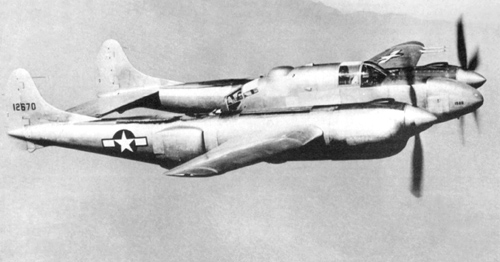- XP-58 Chain Lightning
infobox Aircraft
name =XP-58 Chain Lightning
type =Heavy fighter
manufacturer =Lockheed
caption =The sole completed XP-58
designer =
first flight =1 June 1944
introduced =
retired =
status =Cancelled
primary user =
more users =
produced =
number built =1
unit cost =
variants with their own articles =The Lockheed XP-58 Chain Lightning was an American long-range fighter developed during
World War II . Although derived from the successfulP-38 Lightning , the XP-58 was plagued by technical problems with its engines that eventually led to the cancellation of the project.Design and development
The XP-58 was a
Lockheed Aircraft Company funded initiative to develop an improved Lightning as a long-range fighter following the release by the U.S. Army Air Corps of the Lightning for sale to Britain on20 April 1940 . Initially, two designs were formulated, both using the Continental IV-1440 engines. One would be a single seat aircraft with one 20 mm cannon and four .50 in (12.7 mm) machine guns. The second would be a two-seat aircraft with the addition of a flexible .50 in gun at the end of each tail boom.By July 1940, when use of the Pratt & Whitney XH-2600 was entertained, it was decided that the aircraft would have two seats, and the aircraft was designated XP-58. However, soon Lockheed was advised the development of the XH-2600 engine was terminated. After consideration of the engine alternatives, the design was changed to use two
Wright R-2160 Tornado engines, as well as a change of the rear facing armament to two turrets, one upper and the other lower on the fuselage, each turret containing two .50 in machine guns. As support equipment for the two crewmen was added the estimated weight of the XP-58 grew to lb to kg|34232|sp=us|abbr=on|precision=0 by August 1941.As vacillation continued over the engine and role of the XP-58, the USAAF agreed to a Lockheed proposal for a second XP-58 that would incorporate features to obtain a range of 3,000 miles (4,800 km). In September 1942, a decision was made to convert the aircraft for a role as a low-altitude tank-killer, which introduced complications as the Beechcraft
XA-38 Grizzly was being developed for this role. As a result, the second XP-58 was canceled and the role of the design reverted to that of a high-altitude fighter, but one using 75 mm cannon to break up bomber formations.Testing
In February 1943, use of another engine, the Allison V-3420, was necessary due to poor progress with the Tornado engine development. With this change, the second XP-58 was resurrected. The XP-58 finally flew on
6 June 1944 , but flight test work on the XP-58 took second place to other higher priority developments. Eventually 25 test flights were completed. The XP-58 was then flown to Wright Field for USAAF acceptance tests, even though the turbo-superchargers were experiencing torching and a number of systems were not installed including provision for cockpit pressurization and armament with its fire-control equipment. Although the prototype arrived at Wright Field on22 October 1944 the aircraft was a maintenance headache and no further trials were conducted. The construction of the second prototype was abandoned.pecifications (XP-58)
aircraft specifications
plane or copter?=plane
jet or prop?=prop
crew=two, pilot and gunner
length main=49 ft 4 in
length alt=15.0 m
span main=70 ft
span alt=21.3 m
height main=16 ft
height alt=4.9 m
area main=600 ft²
area alt=56 m²
empty weight main=21,624 lb
empty weight alt=9,808 kg
loaded weight main= lb
loaded weight alt= kg
max takeoff weight main=39,192 lb
max takeoff weight alt=17,777 kg
engine (prop)=Allison V-3420
type of prop= 24 cylinder liquid-cooled engines
number of props= 2
power main= 3,000 hp
power alt= 2,200 kW
max speed main=436 mi/h at 25,000 ft
max speed alt=702 km/h
range main=statute miles
range alt=km
ceiling main=38,400 ft
ceiling alt=11,700 m
climb rate main= 2,660 ft/min
climb rate alt= 13.5 m/min
loading main=kg/m²
loading alt= lb/ft²
power/mass main= 0.15 hp/lb
power/mass alt= 0.12 kW/kg
armament=
*Four 37 mm cannon and four .50 in (12.7 mm) machine guns in two remotely controlled flexible turrets or,
*One 75 mm cannon and two .50 in (12.7 mm) machine guns in the nose and two turrets.ee also
aircontent
related=
similar aircraft=*
Bristol Beaufighter
*P-61 Black Widow lists=
see also=
*List of Lockheed aircraft References
Notes
Bibliography
* Green, William. "War Planes of the Second World War, Volume Four: Fighters". London: MacDonald & Co. (Publishers) Ltd., 1961 (Sixth impression 1969). ISBN 0-356-01448-7.
* Green, William and Swanborough, Gordon. "WW2 Aircraft Fact Files: US Army Air Force Fighters, Part 2". London: Macdonald and Jane's Publishers Ltd., 1978. ISBN 0-354-01072-7.
Wikimedia Foundation. 2010.
